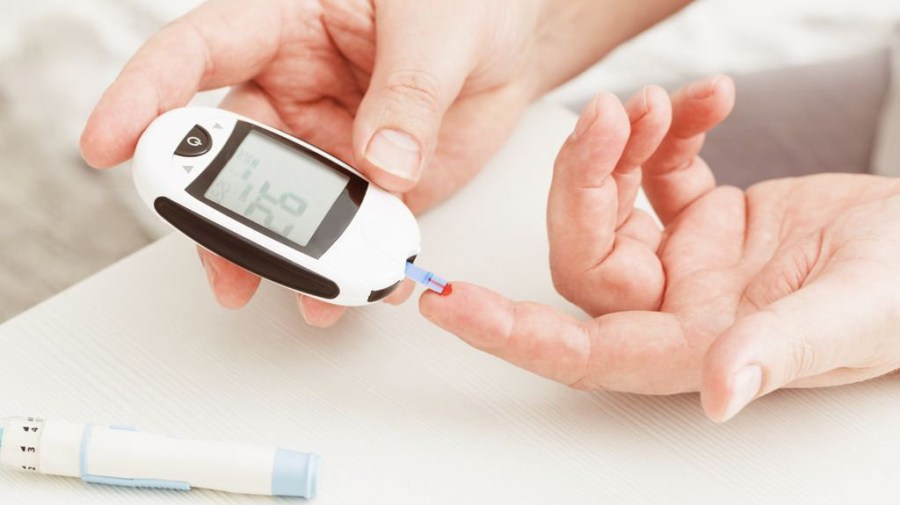
When it’s time for your annual checkup, your doctor will probably order some routine blood tests to check basic health indicators like white and red blood cell counts, cholesterol levels and blood glucose level — also known as your blood sugar. Patients generally get phone calls later letting them know that their blood work was fine, but what happens when the results show a reading in an abnormal range?
When it comes to blood glucose, a high reading could indicate diabetes, a disease that requires a specific diet and possibly medication. It depends on the number and the circumstances at the time of the test. Blood glucose levels can be temporarily impacted by eating and drinking, for example. In most cases, your doctor will repeat the glucose blood test while you are fasting and possibly order more extensive tests to determine if your blood glucose is consistently high. Here’s what you need to know about the results.
What Does Glucose Do for the Body?
Your body needs a certain amount of glucose (sugar) to run properly. Without it, your cells and organs wouldn’t have the energy they need to function. Most of the glucose in the human body comes from the foods we eat. As the glucose builds up in your blood after eating, insulin — a hormone made by the pancreas — enables the glucose to enter other cells in your body to be used as energy. This process keeps your blood sugar level within a normal range.
If there isn’t enough insulin in your body (Type 1 diabetes) or your body doesn’t use the insulin properly (Type 2 diabetes), your blood glucose level builds up. Chronic high blood sugar levels can cause severe health problems, including heart disease, kidney disease and stroke.
What Is a High Glucose Level?
A high level of glucose in your blood is a hallmark of diabetes, a serious health condition that affects more than 34 million people in the United States, or slightly more than 10% of the population, according to the American Diabetes Association. However, moderately high glucose levels may only indicate prediabetes, a warning condition that often occurs before Type 2 diabetes develops. Your doctor will confirm an exact diagnosis in a couple of ways.
A fasting blood glucose test checks your sugar levels after fasting for eight hours. If your glucose level is more than 126 mg/dL (milligrams of sugar per deciliter of blood) on more than one test, you most likely have diabetes. Your doctor may order an expanded test known as an oral glucose tolerance test to confirm the diagnosis. For this test, you fast for eight hours and drink a sugary liquid. Then, your blood is tested several times for several hours. If your blood sugar is more than 200 mg/dL after two hours, it confirms a diagnosis of diabetes. A blood sugar level of 140-199 mg/dL indicates prediabetes. A reading below 140 mg/dL would be considered normal for this test.
Many doctors now use a glycated hemoglobin test, also known as an A1C test, to diagnose diabetes. This test indicates your average blood sugar for the past two to three months and can be conducted at any time without fasting. If your A1C level on more than one test is higher than 6.5%, you have diabetes. A normal A1C level is less than 5.7%, while a prediabetes level measures between 5.7% and 6.4%.
Why Is High Blood Sugar a Bad Thing?
Put simply, high blood sugar acts similar to a poison in your body. It further hinders your pancreas — which is already struggling — from producing insulin and can permanently damage the organ as well as many others, including your heart. It can cause changes in your blood vessels that cause a range of problems, including nerve damage known as neuropathy. This damage causes tingling, numbness and burning in your extremities. The risk of kidney disease and heart disease goes up with diabetes, and you could be more susceptible to heart attack or stroke.
Diabetic retinopathy damages the blood vessels in the eyes, causing vision impairment. A weakened immune system and poor blood circulation to the hands and feet could ultimately lead to amputation of affected limbs. Prolonged high blood glucose leads to diabetic ketoacidosis, a condition that causes a coma or even death. The risk of permanent damage from the complications of diabetes increases the longer your blood sugar remains high.
What Are Normal Blood Sugar Levels?
A normal blood sugar reading for someone without diabetes would fall between 80-99 mg/dL. If you have diabetes, you should aim to keep your blood sugar between 80-130 mg/dL. About one to two hours after eating a meal, your blood sugar should measure below 180 mg/dL. These numbers are general and may not fit your situation for a number of reasons. Be sure to discuss your individual target levels with your doctor.
How Can High Blood Sugar Be Controlled?
If you have been diagnosed with diabetes, you may need to test your blood sugar daily — or even several times a day — with a blood glucose meter. These devices require you to prick your finger and put a drop of blood on a test strip that is inserted into the reader. The results are displayed within minutes.
People with Type 1 diabetes do not make insulin and must take insulin injections, usually several times a day. Those with Type 2 diabetes may be able to control their blood sugar by modifying their diet and exercising. If lifestyle changes aren’t enough to lower blood sugar and manage the condition, oral medications and/or insulin injections are needed as well.
Resource Links:
https://www.mayoclinic.org/diseases-conditions/diabetes/symptoms-causes/syc-20371444
https://www.diabetes.org/resources/statistics/statistics-about-diabetes
https://www.diabetes.org/diabetes-risk/prediabetes
https://www.mayoclinic.org/diseases-conditions/diabetes/diagnosis-treatment/drc-20371451
https://www.thediabetescouncil.com/what-are-blood-sugar-target-ranges/





